Abstract
1. Isolated lung lobes of the dog perfused through the pulmonary circulation only with atropinized autologous blood obtained by bleeding out the animal under general anaesthesia or following premedication with morphine hydrochloride were subjected to repetitive tests of ventilation hypoxia, the control and test gas mixtures containing similar concentrations of CO2.
2. The pulmonary vasomotor response to ventilation hypoxia depended upon the temperature of the perfusate and the time which had elapsed from the death of the animal to the start of perfusion, termed the `ischaemic period'. The higher blood temperatures and shorter ischaemic periods favoured a pulmonary vasopressor response to hypoxia, and the lower temperatures and longer ischaemic periods a vasodepressor response or an absence of response.
3. The vasopressor responses to hypoxia were associated with a rise in the pH (average, 0·09 in 5 experiments) and a fall in the PCO2 of the blood. There were no consistent changes in the pH and PCO2 of the blood accompanying vasodepressor responses.
4. The vasopressor responses could be obtained over periods of perfusion lasting 4 hr or longer.
5. It is suggested that changes in the composition of blood equilibrated in the isolated perfused lung cannot be predicted from in vitro dissociation curves.
Full text
PDF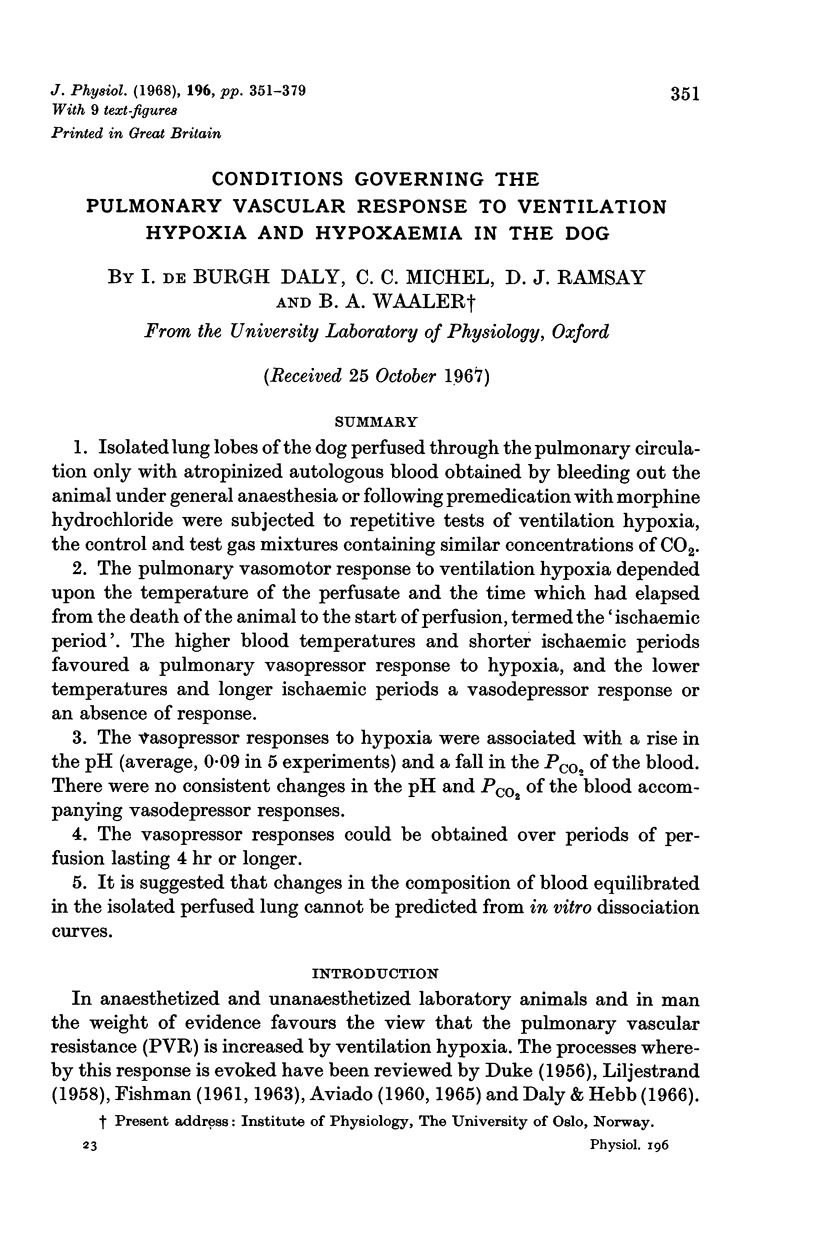
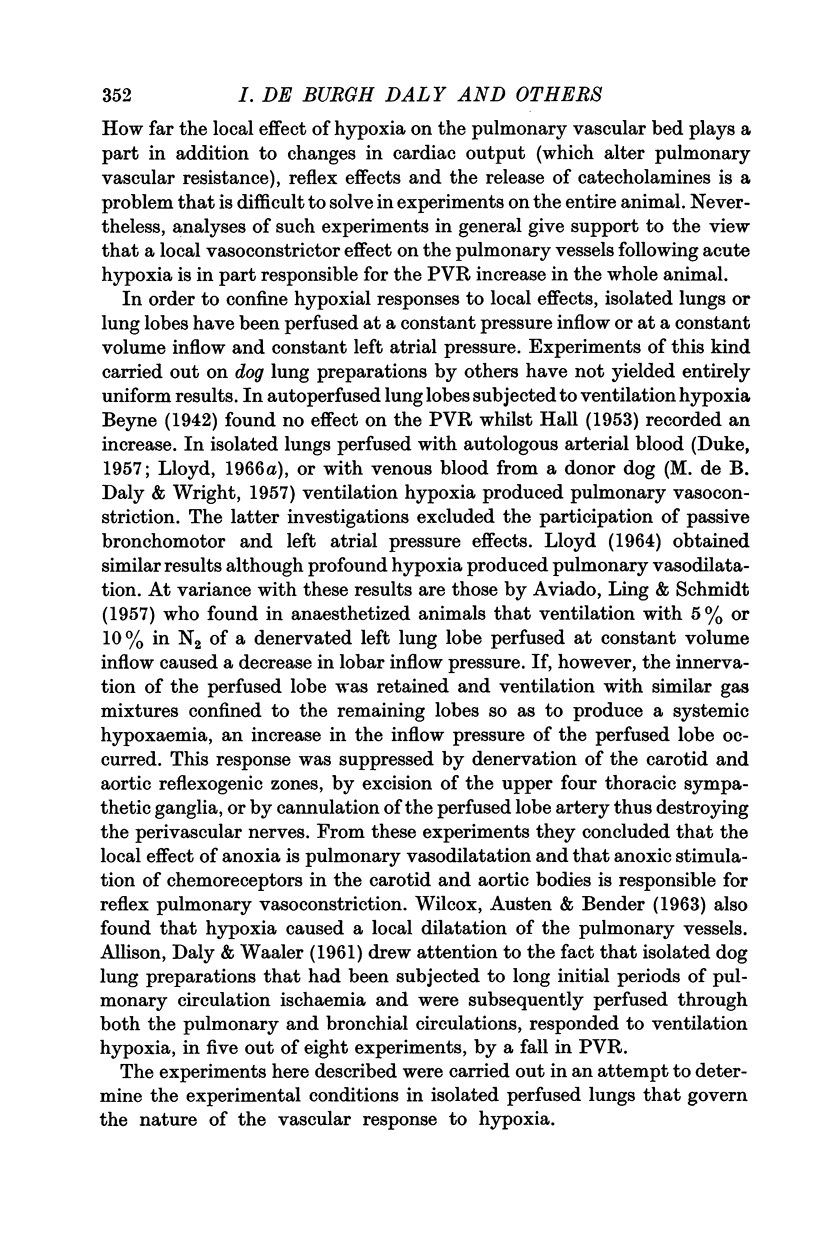
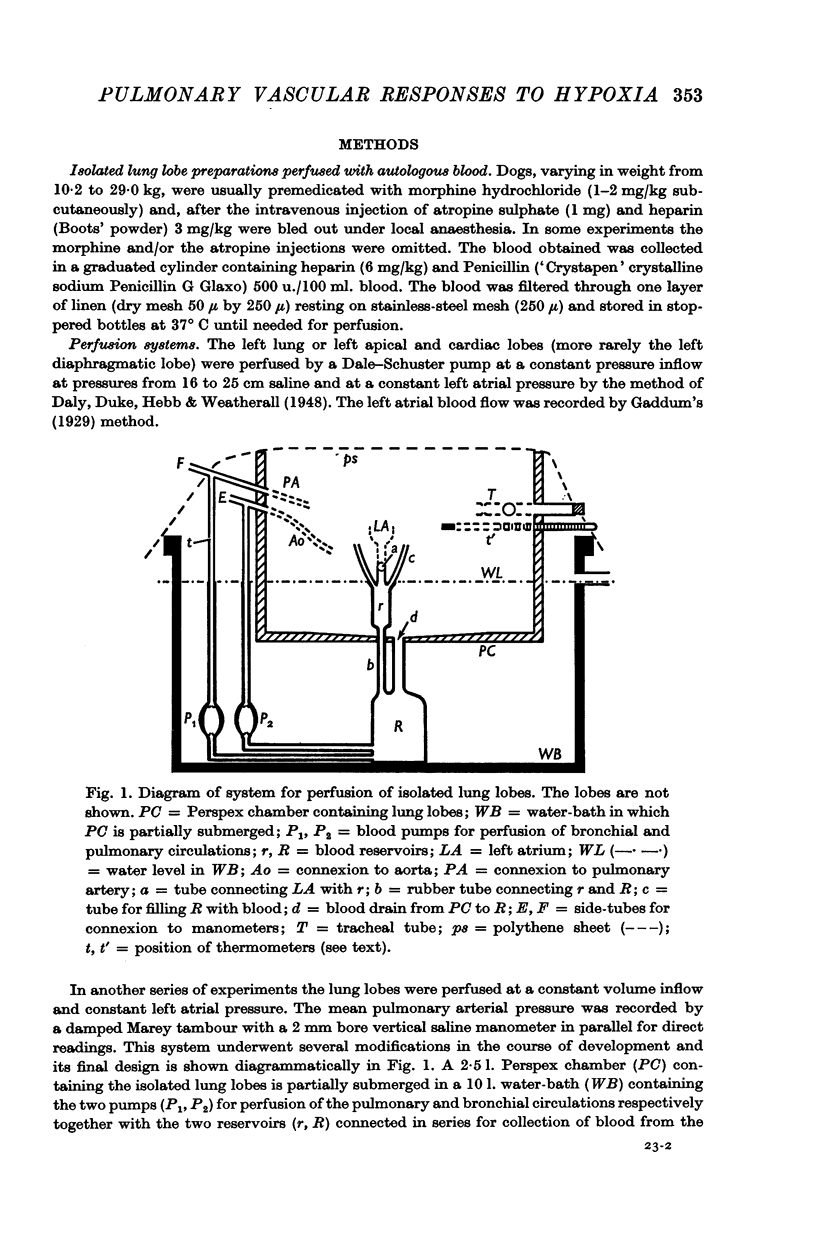
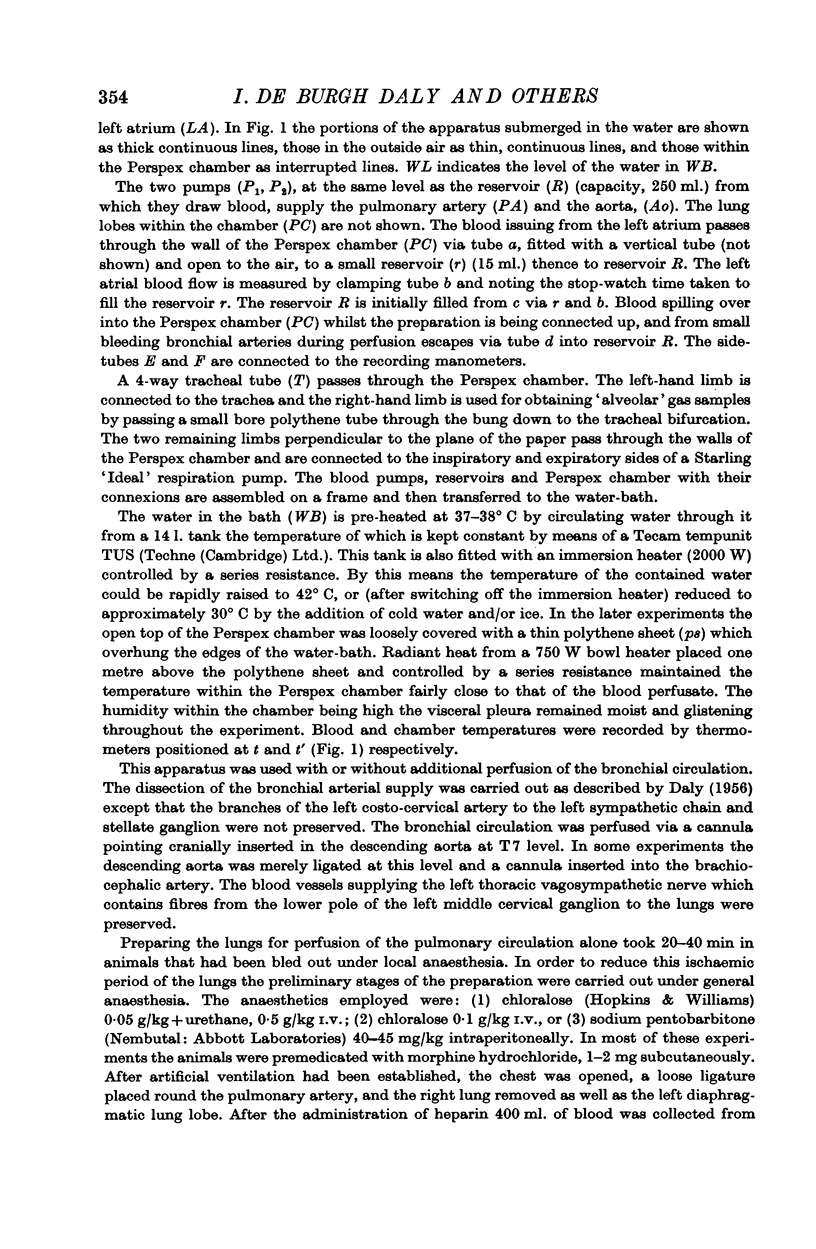
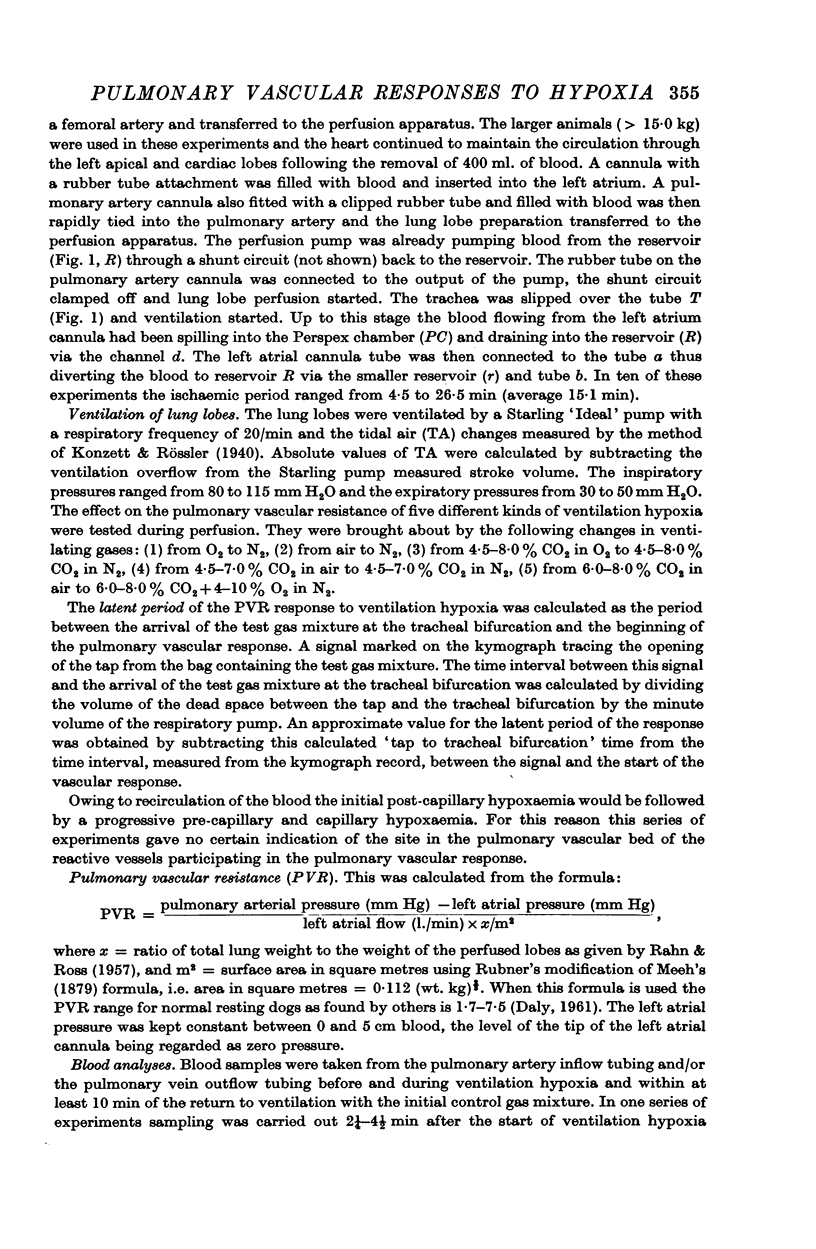
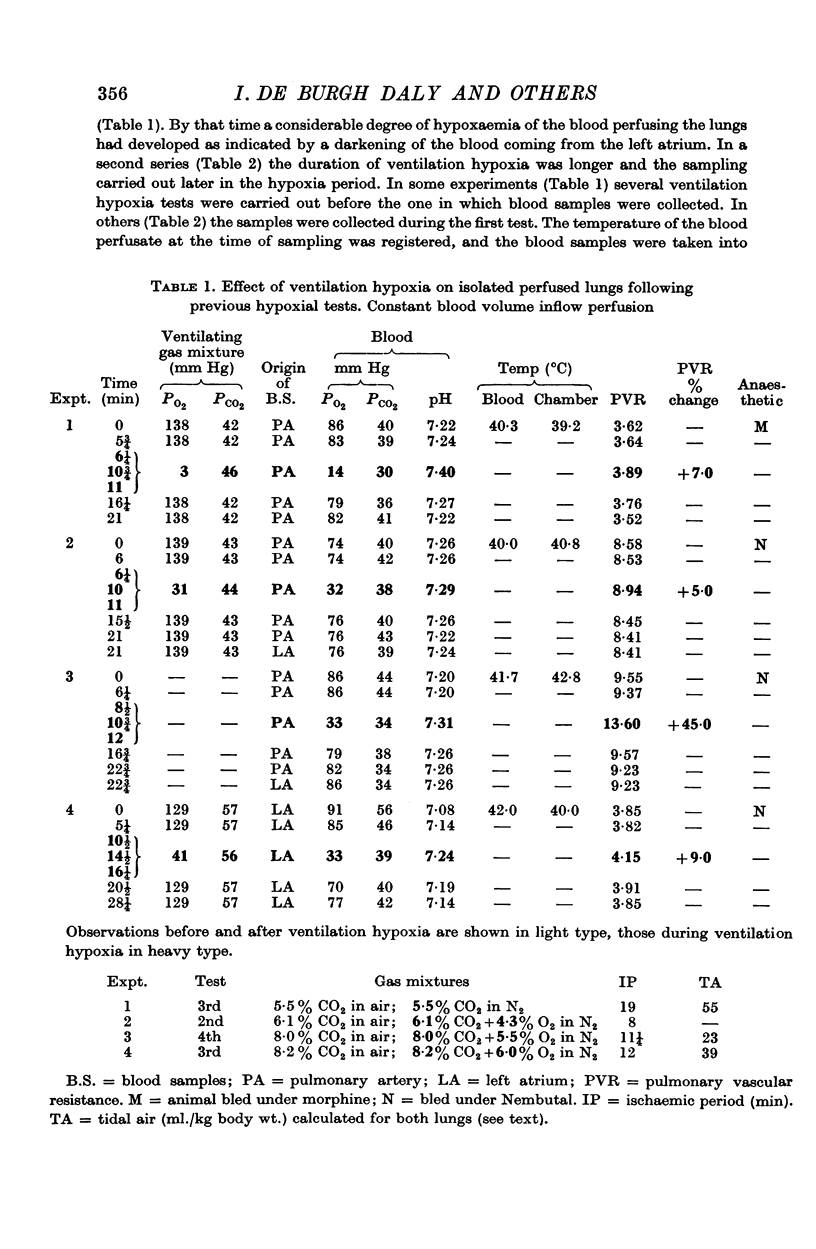
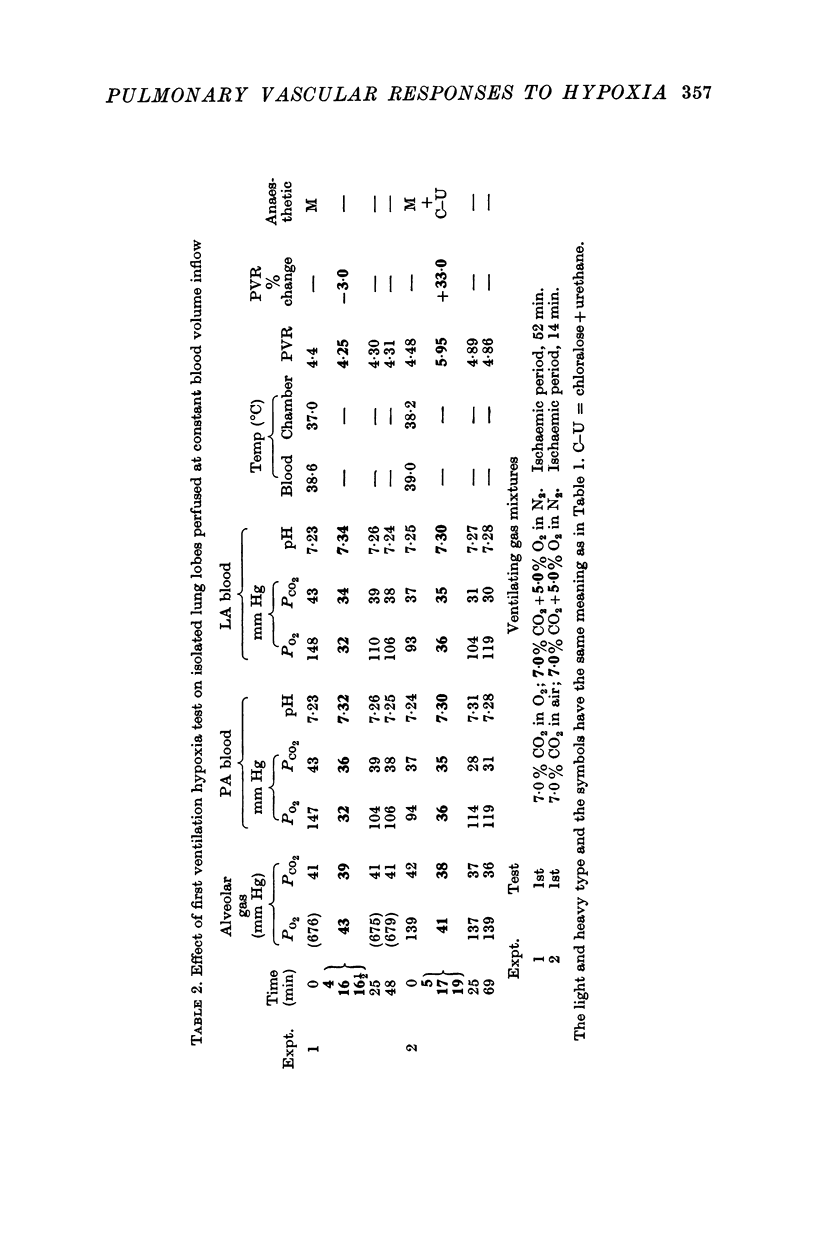
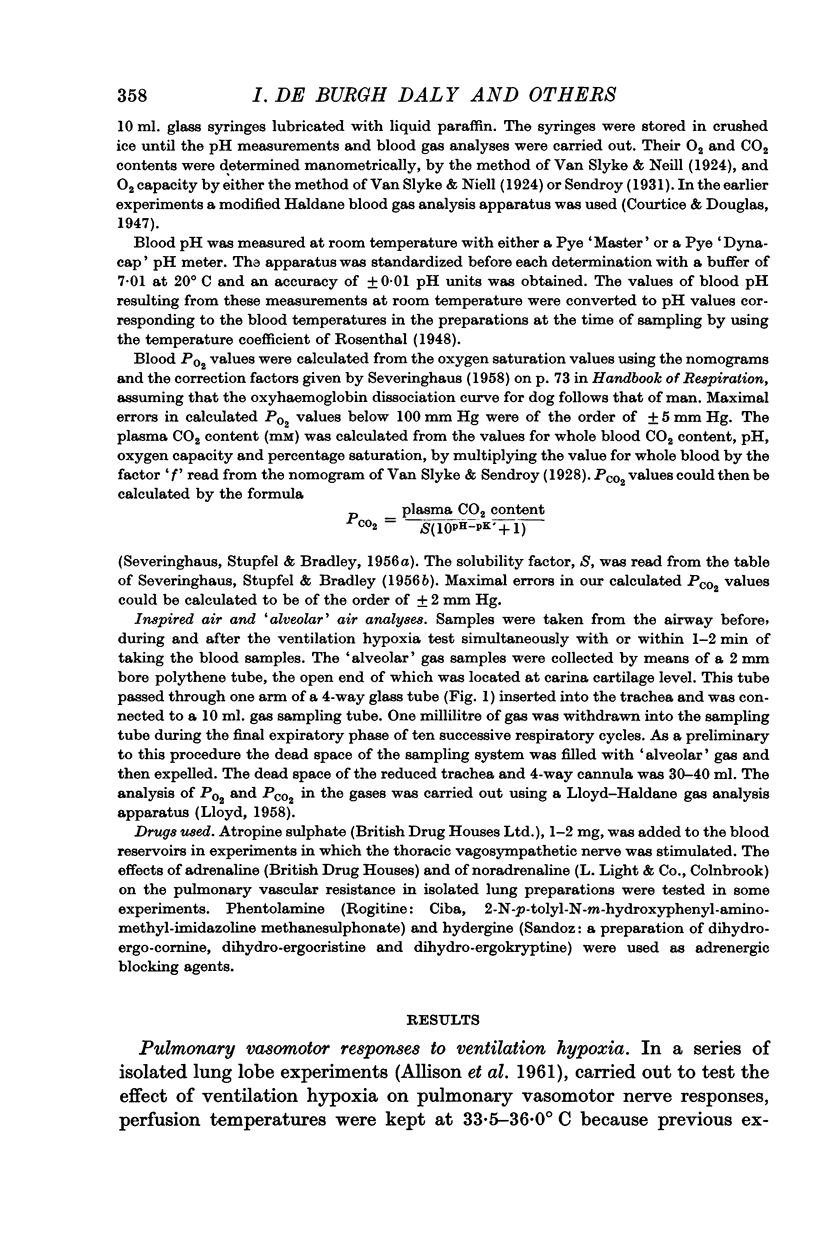
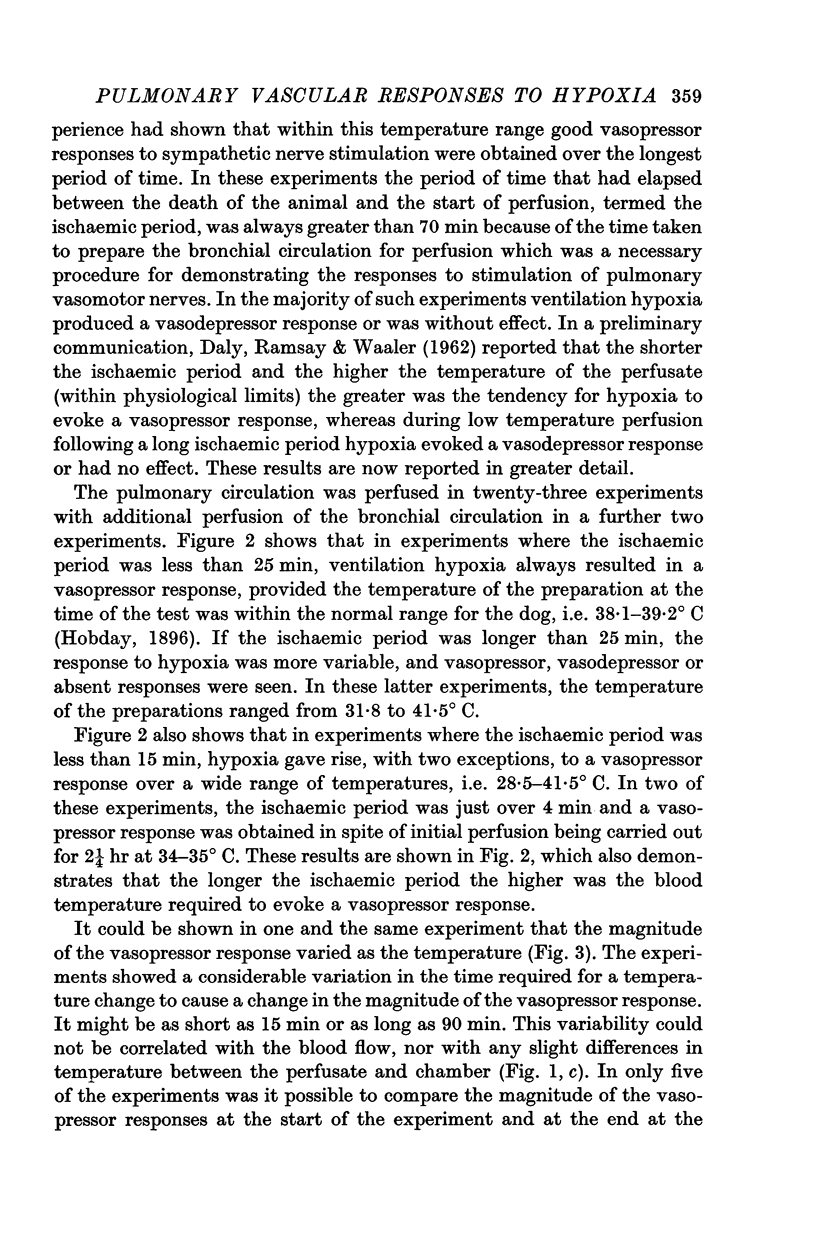
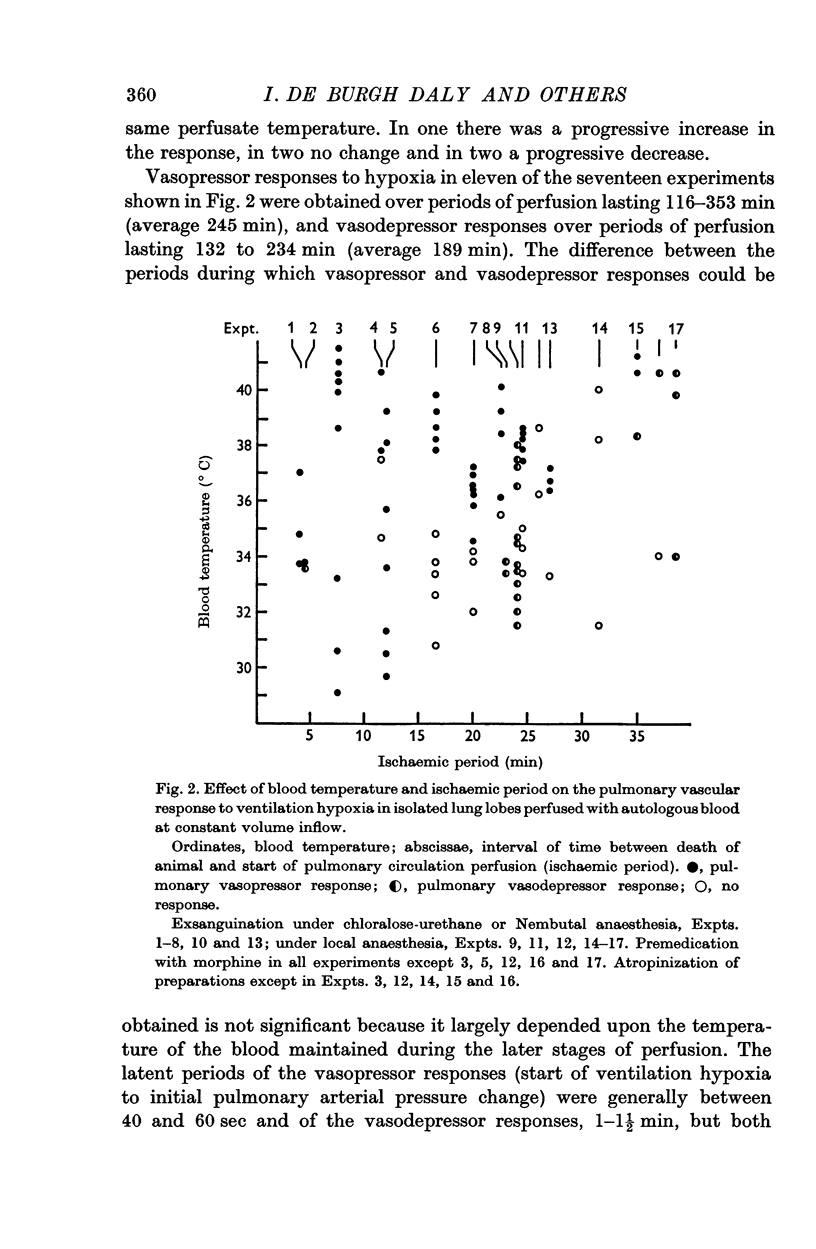
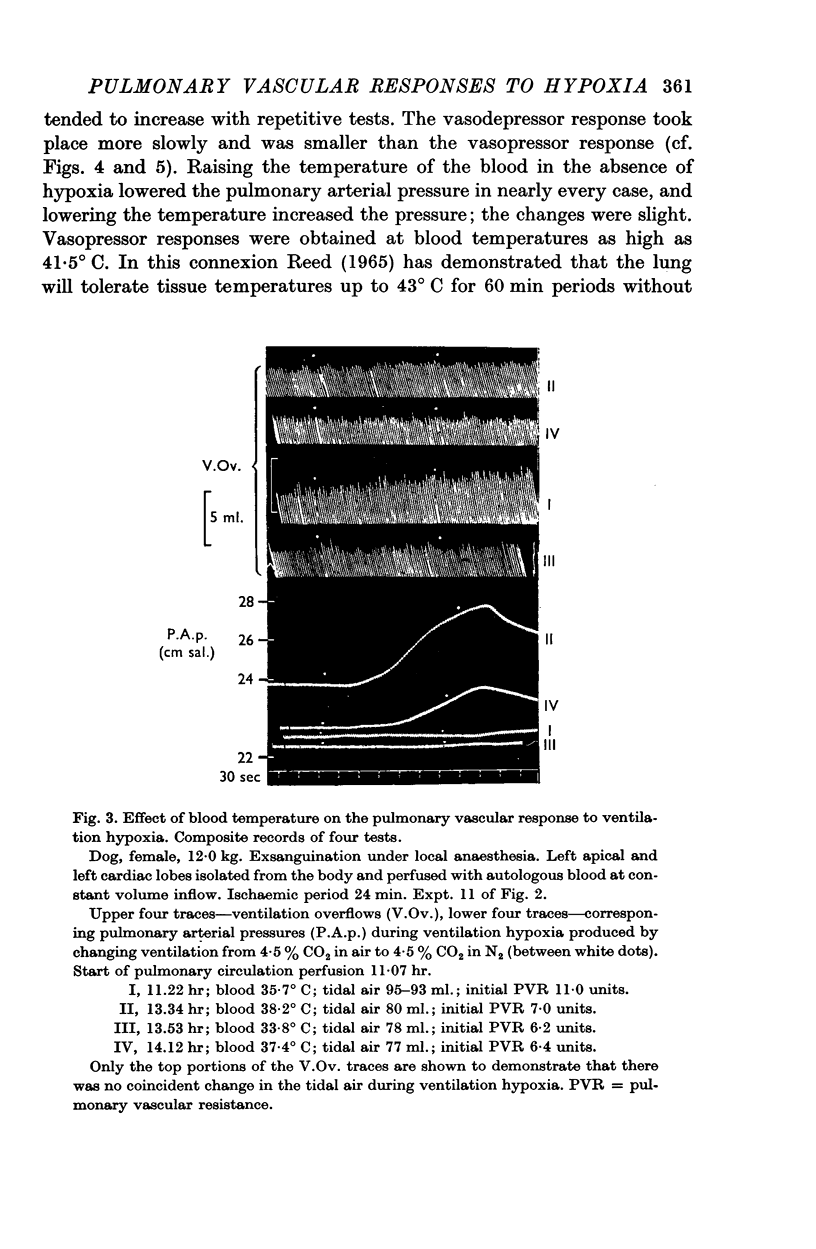
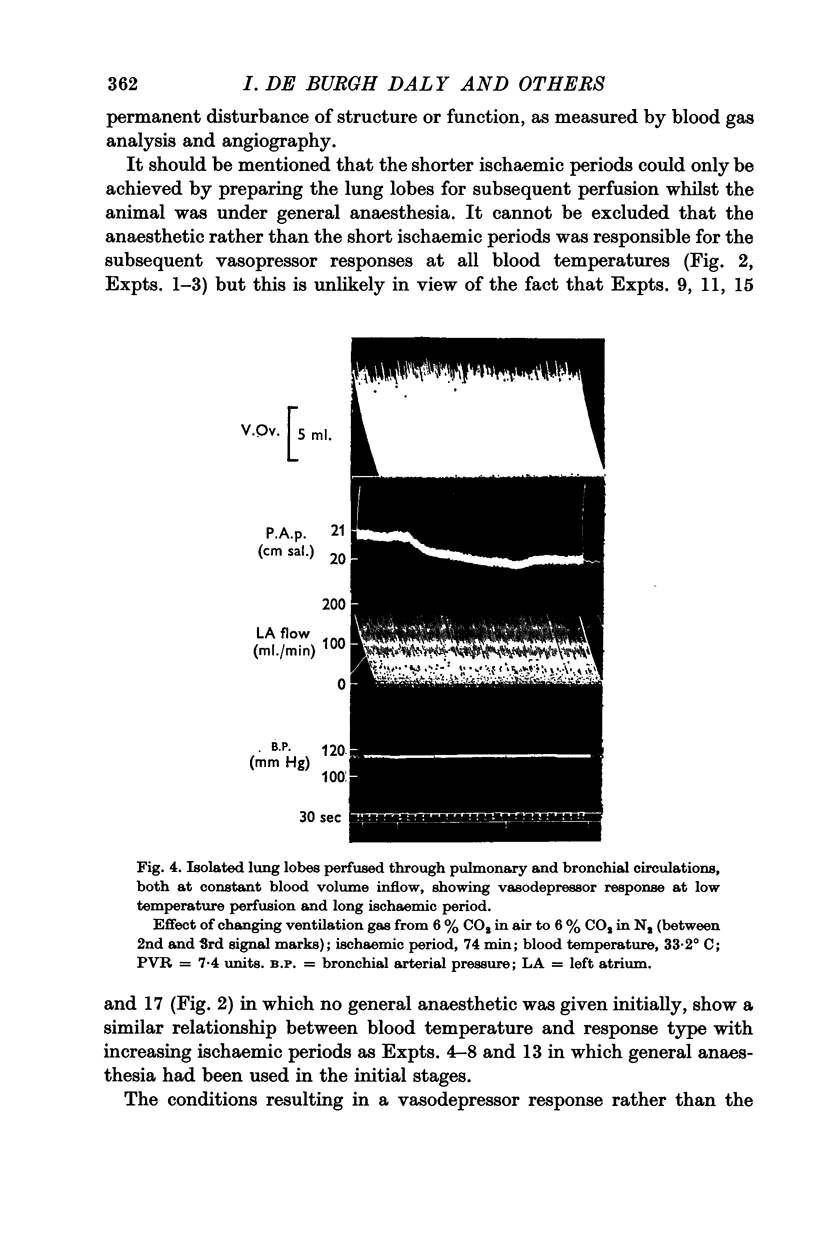
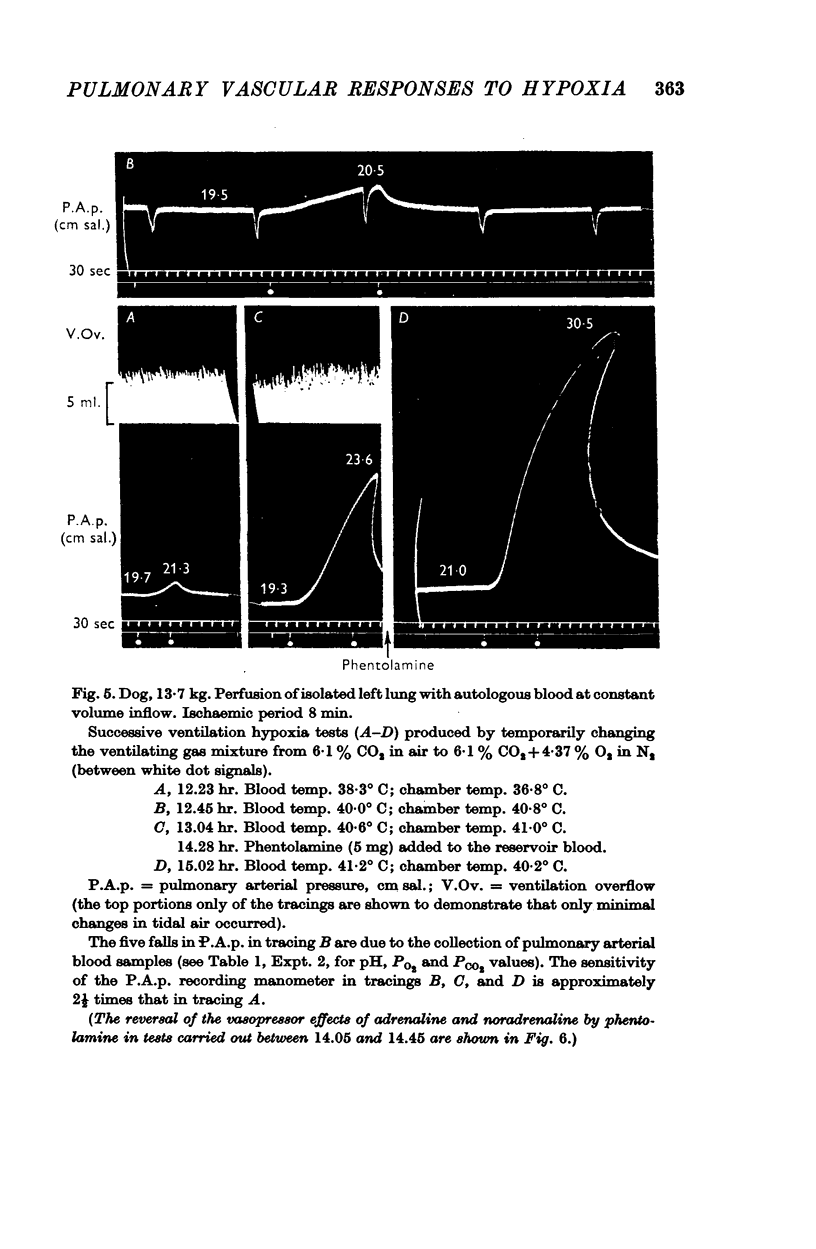
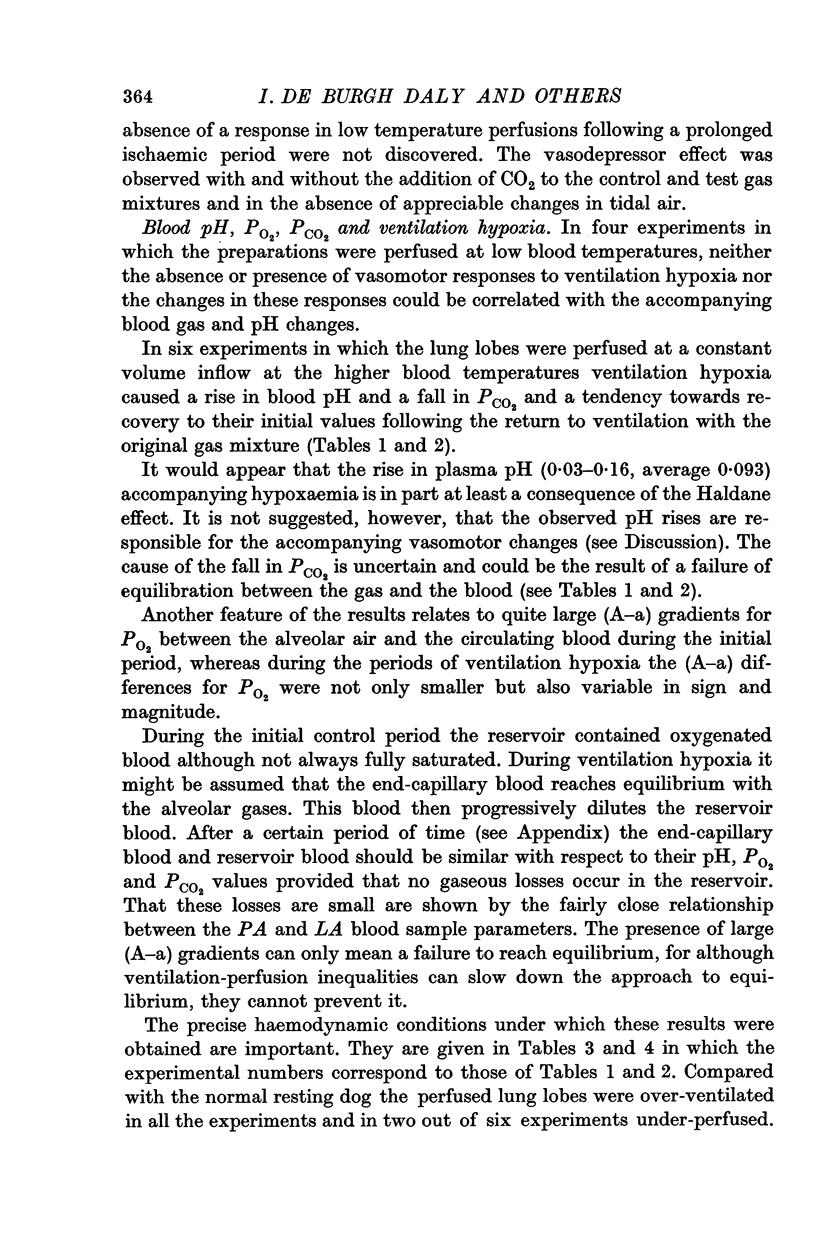
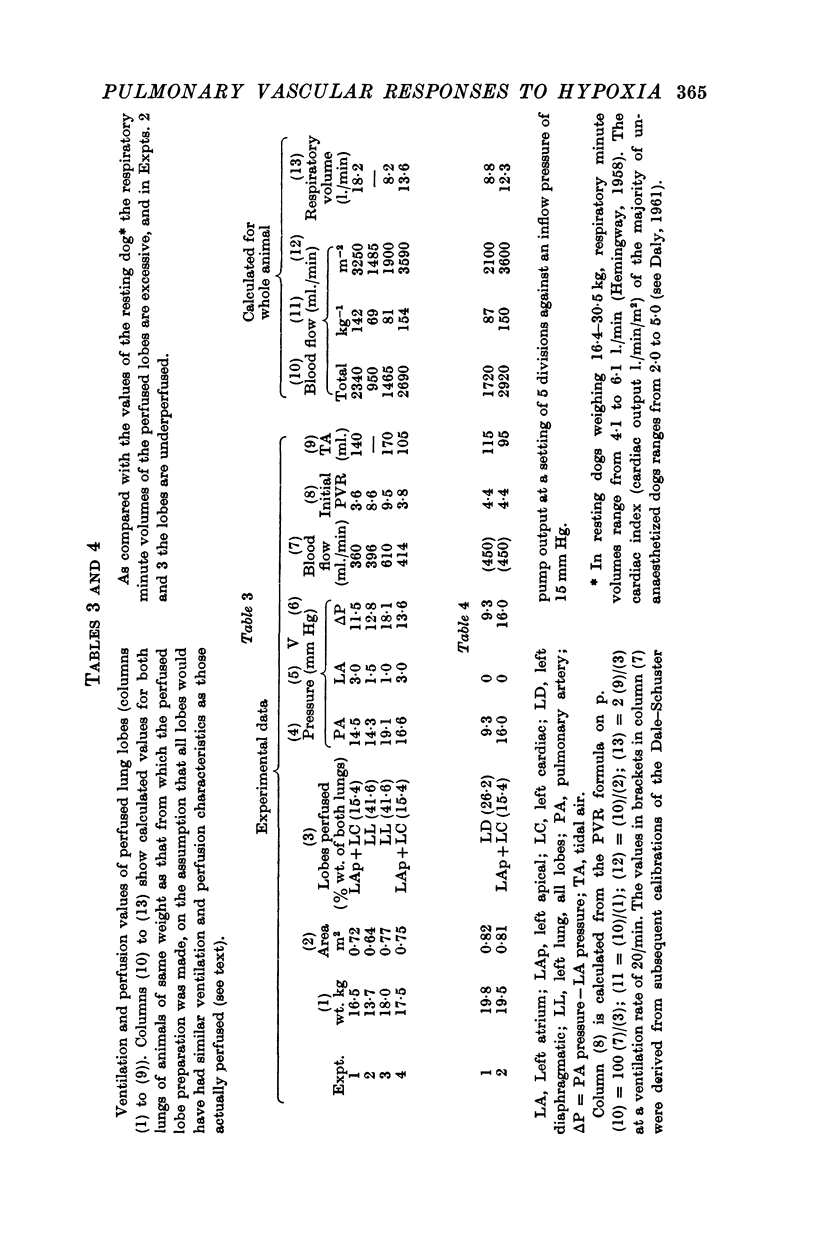
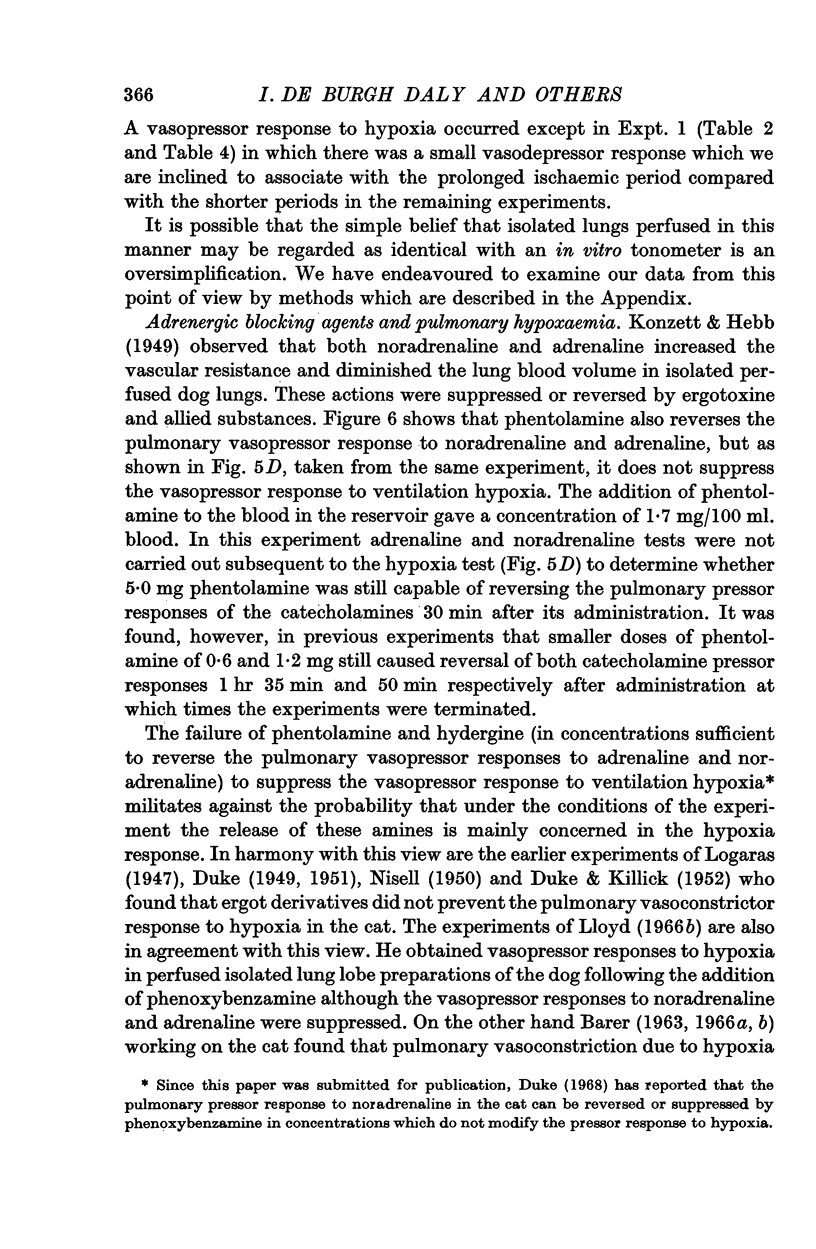
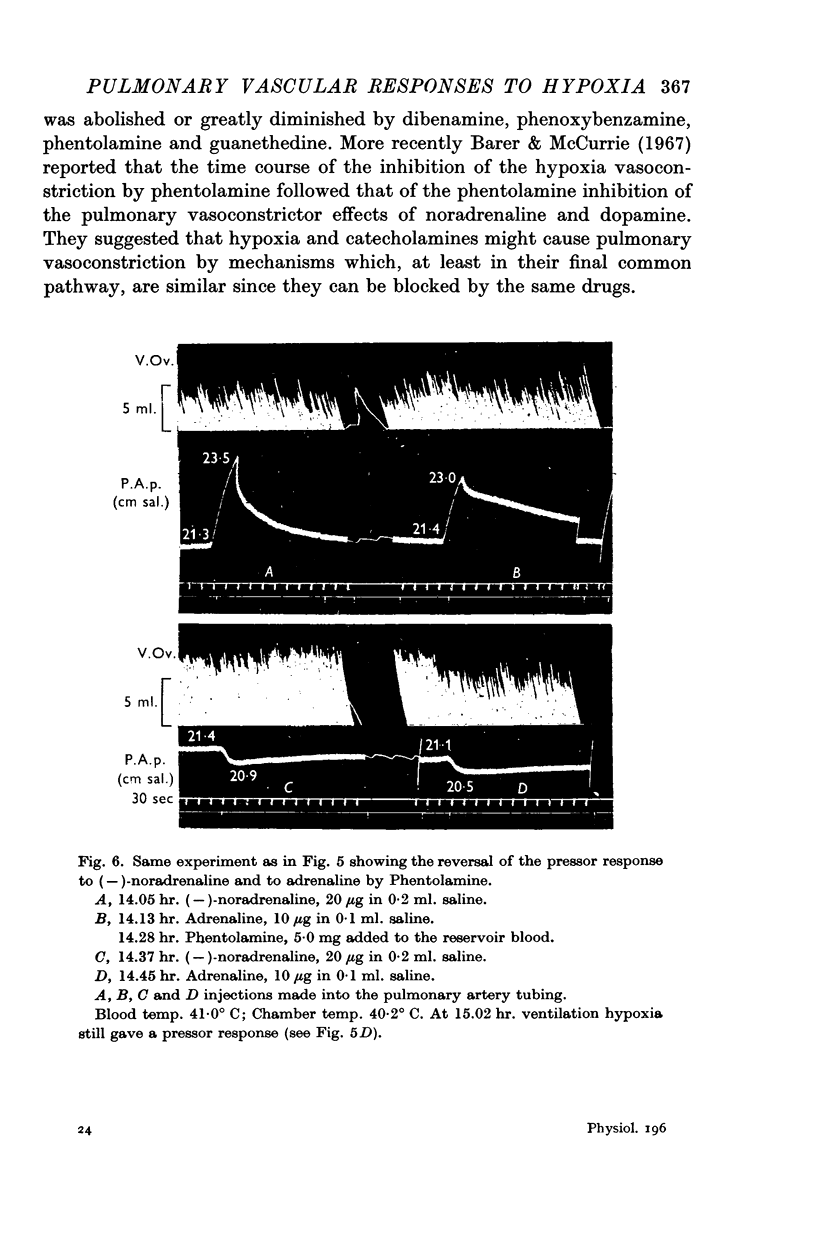
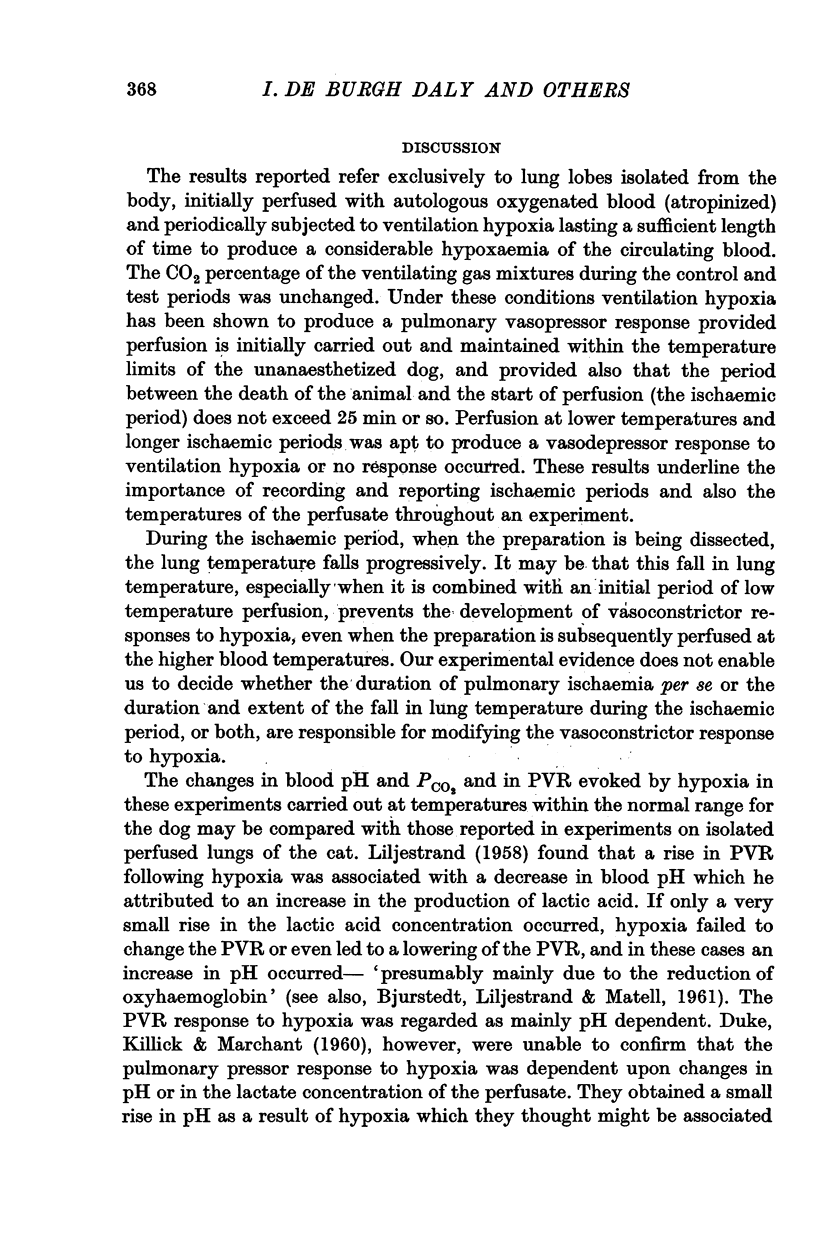
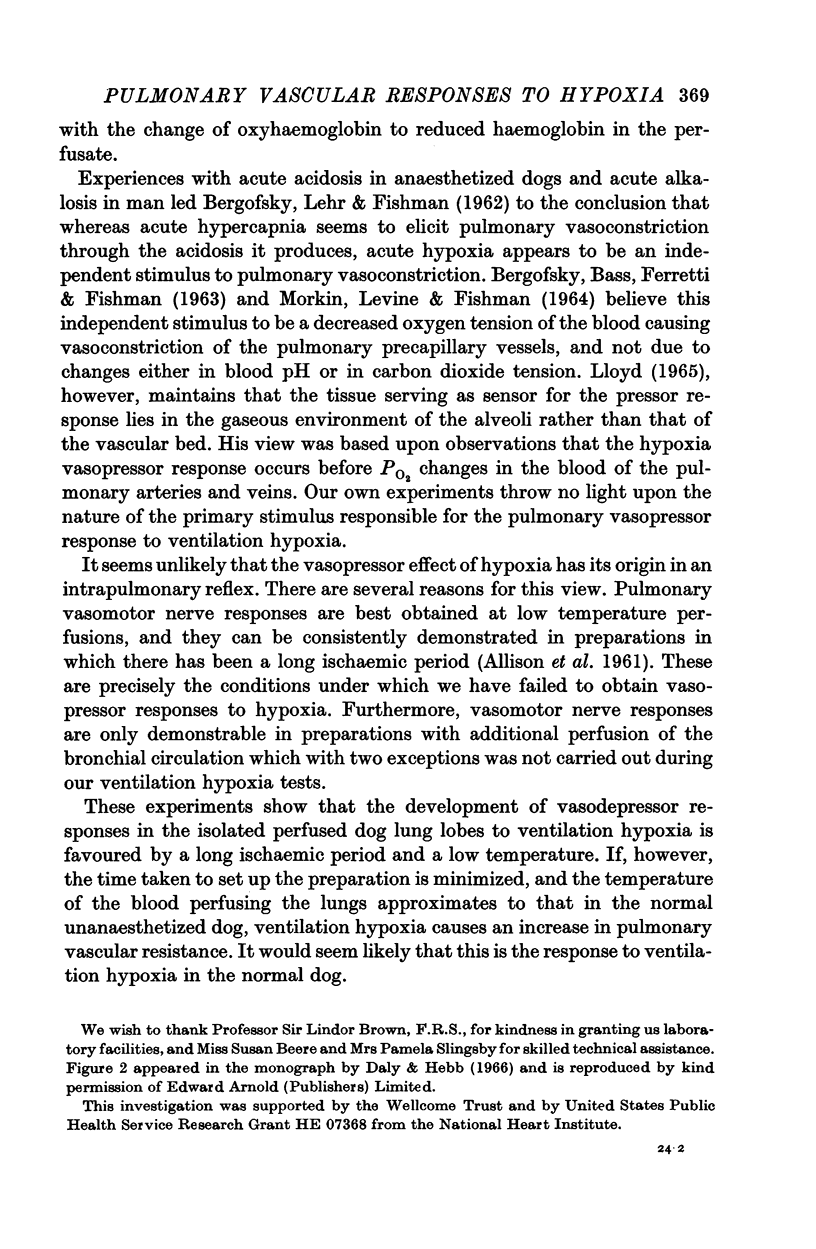
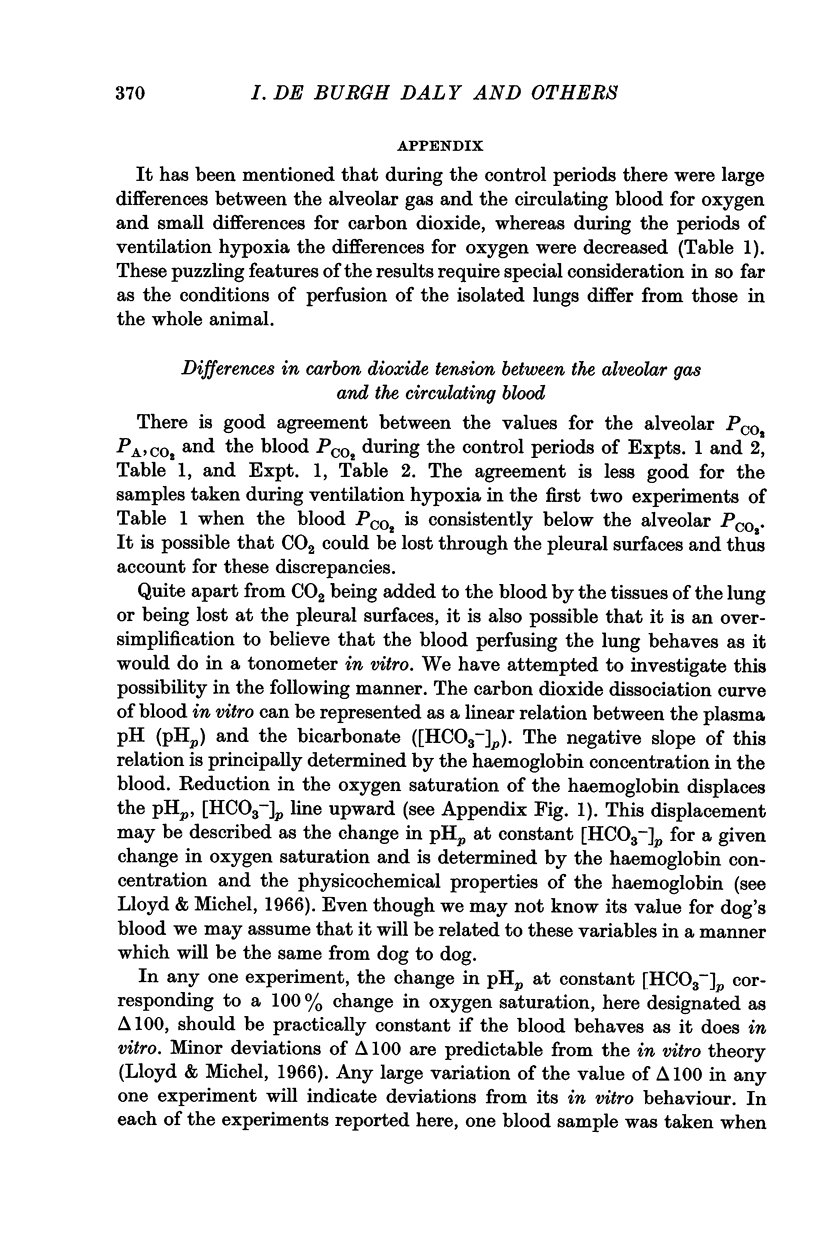
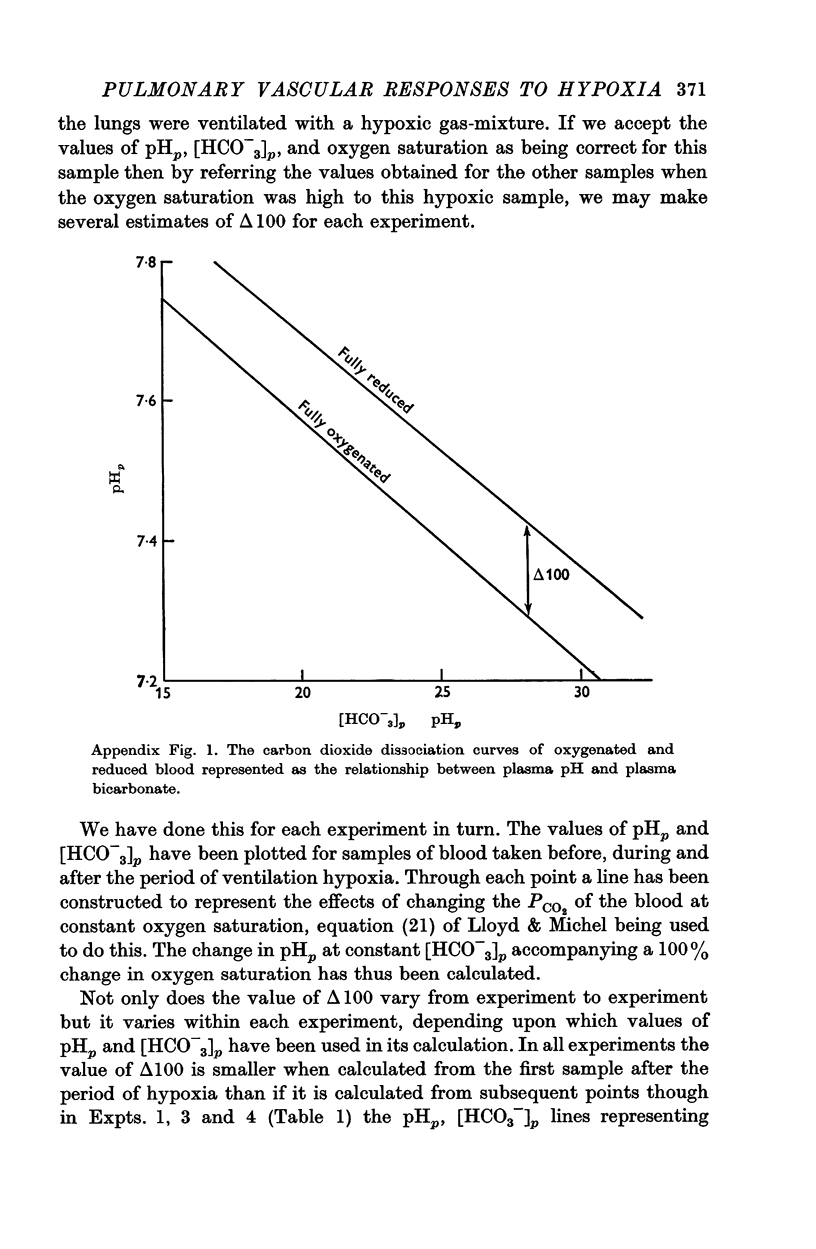
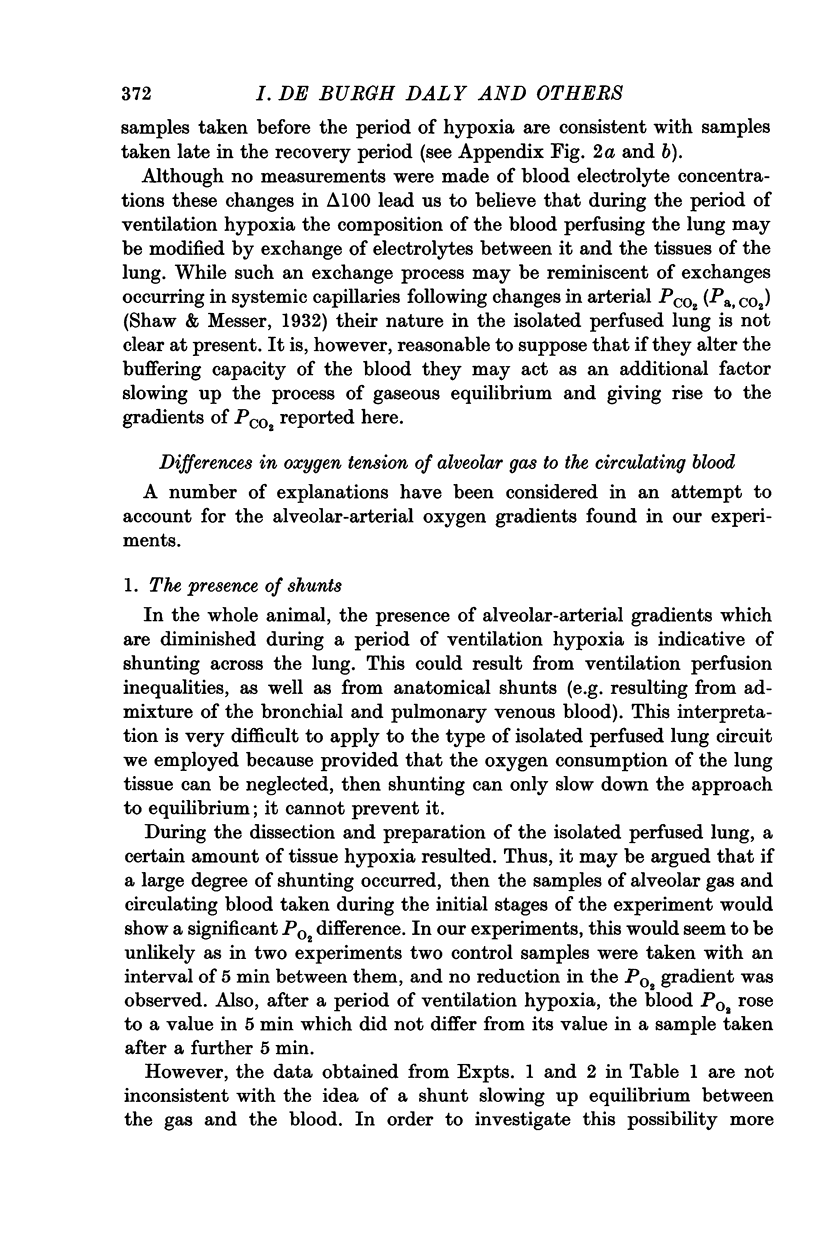
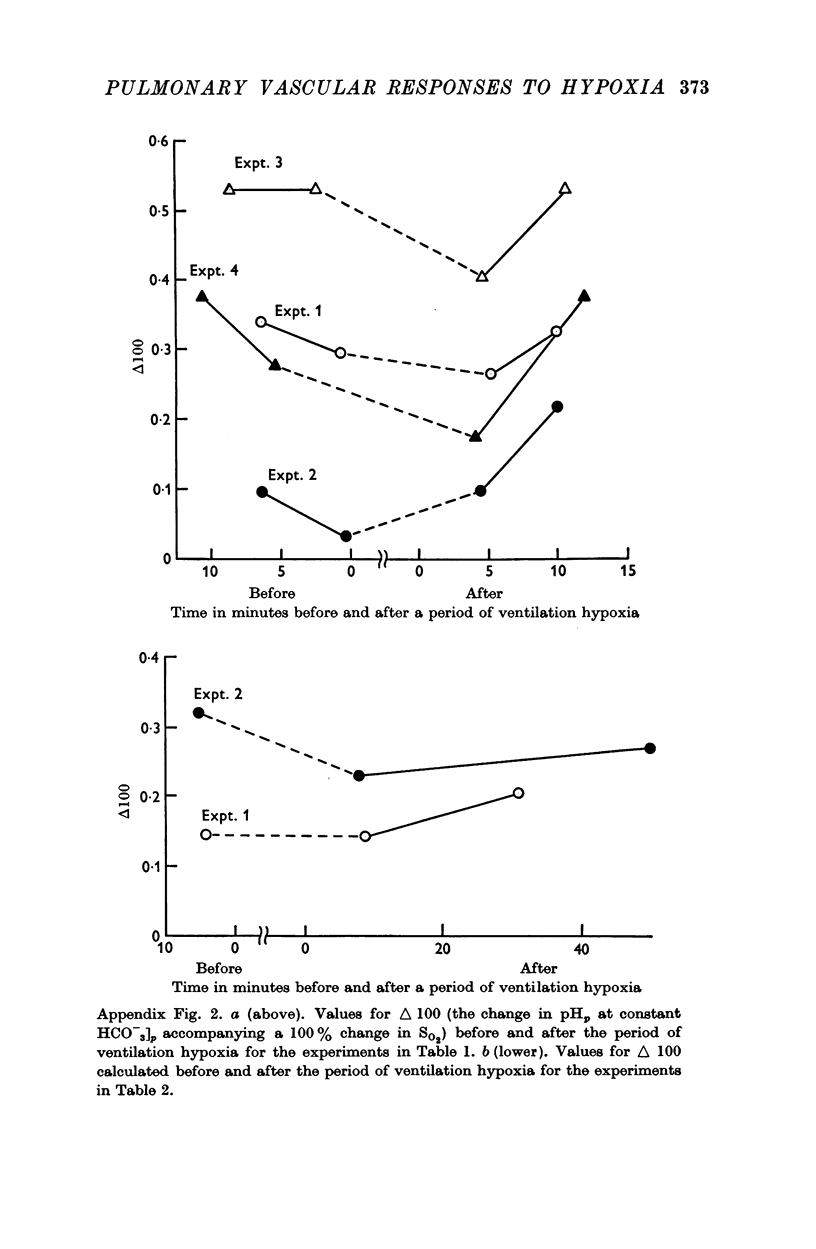
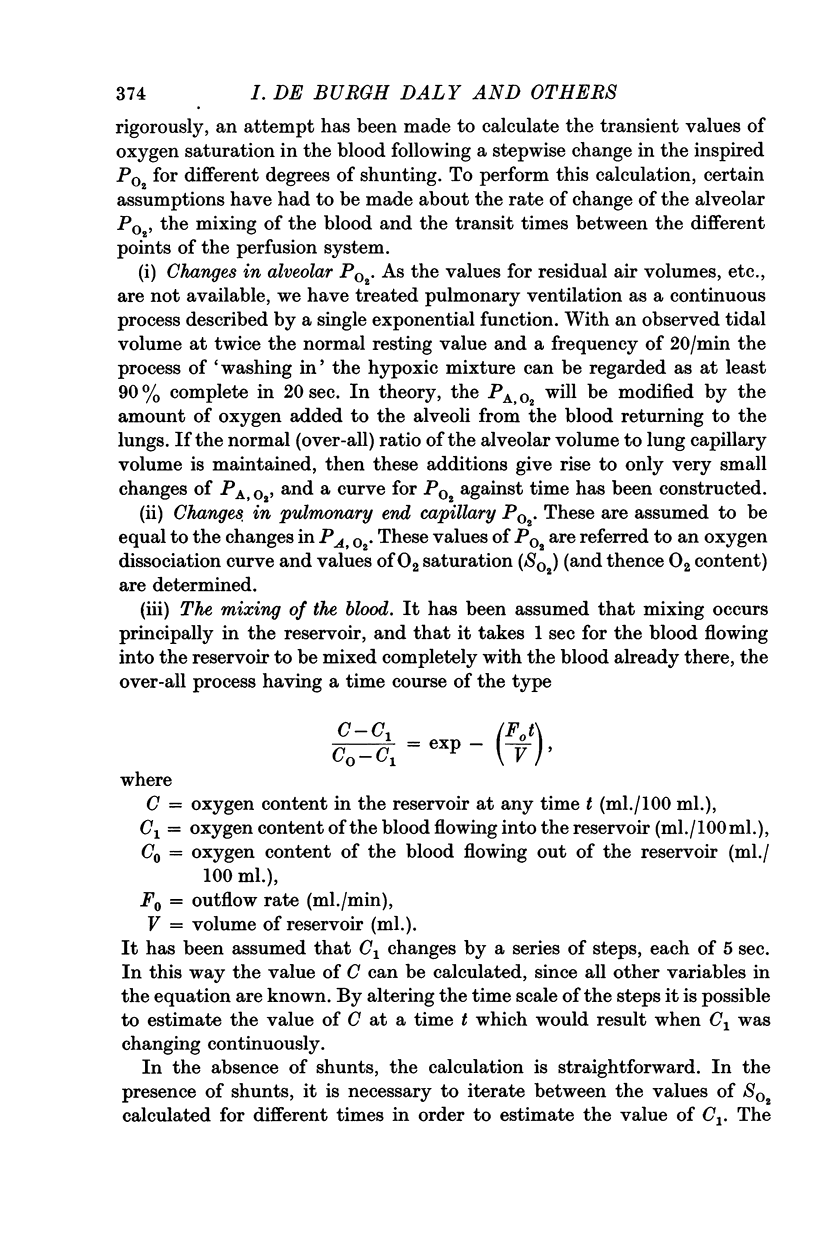
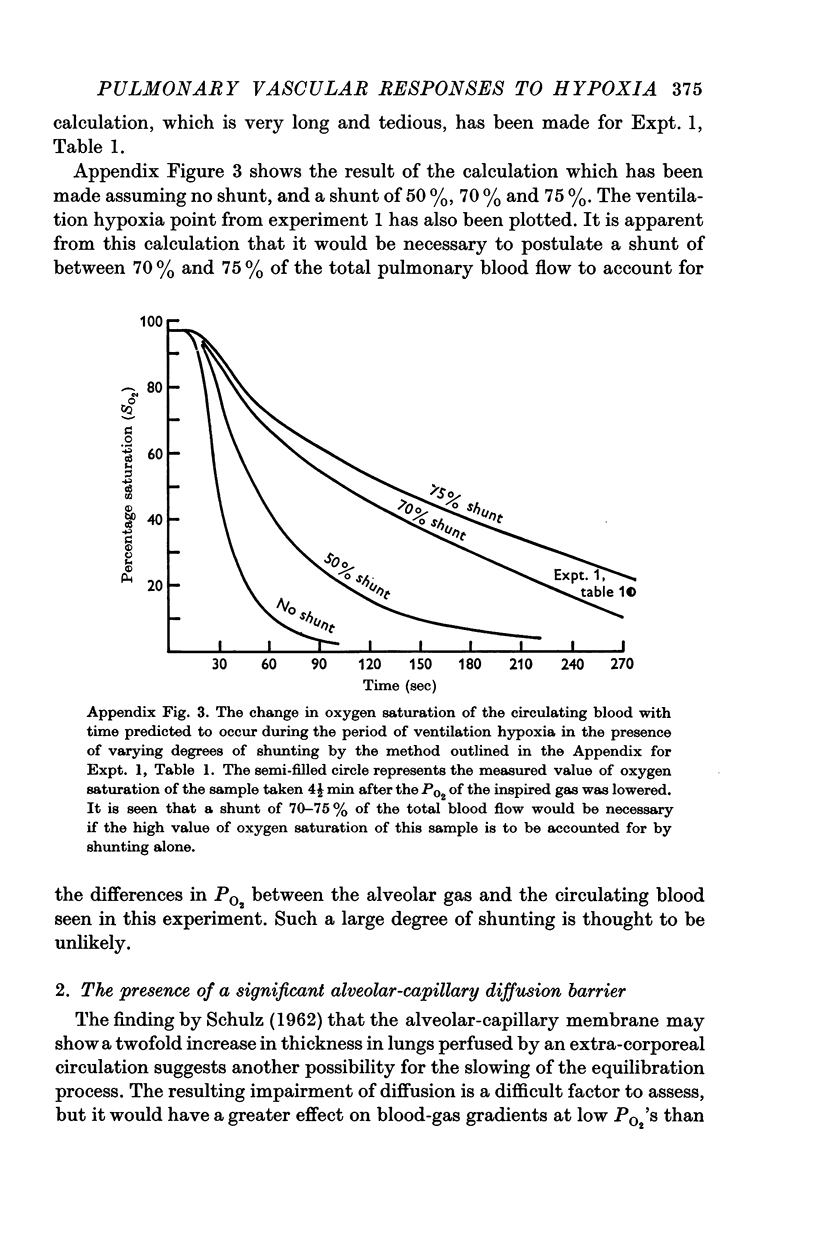
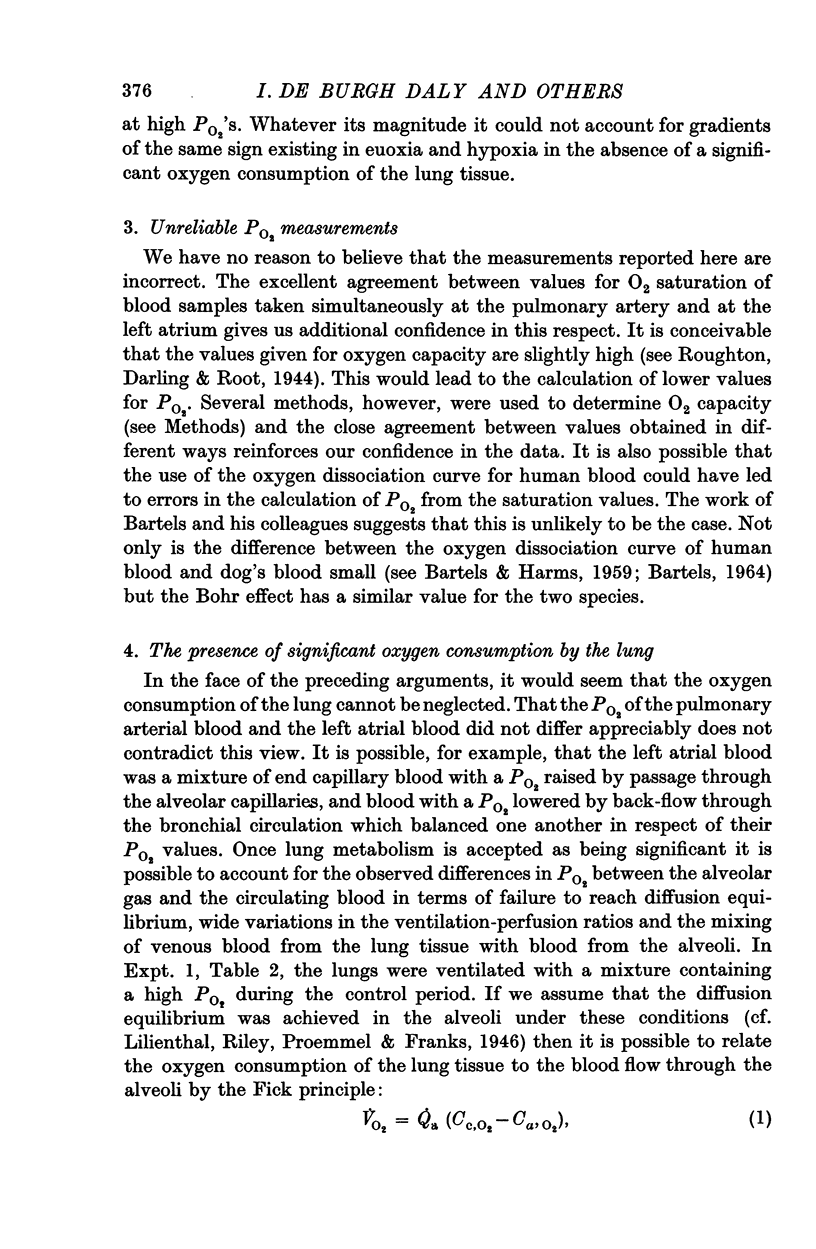
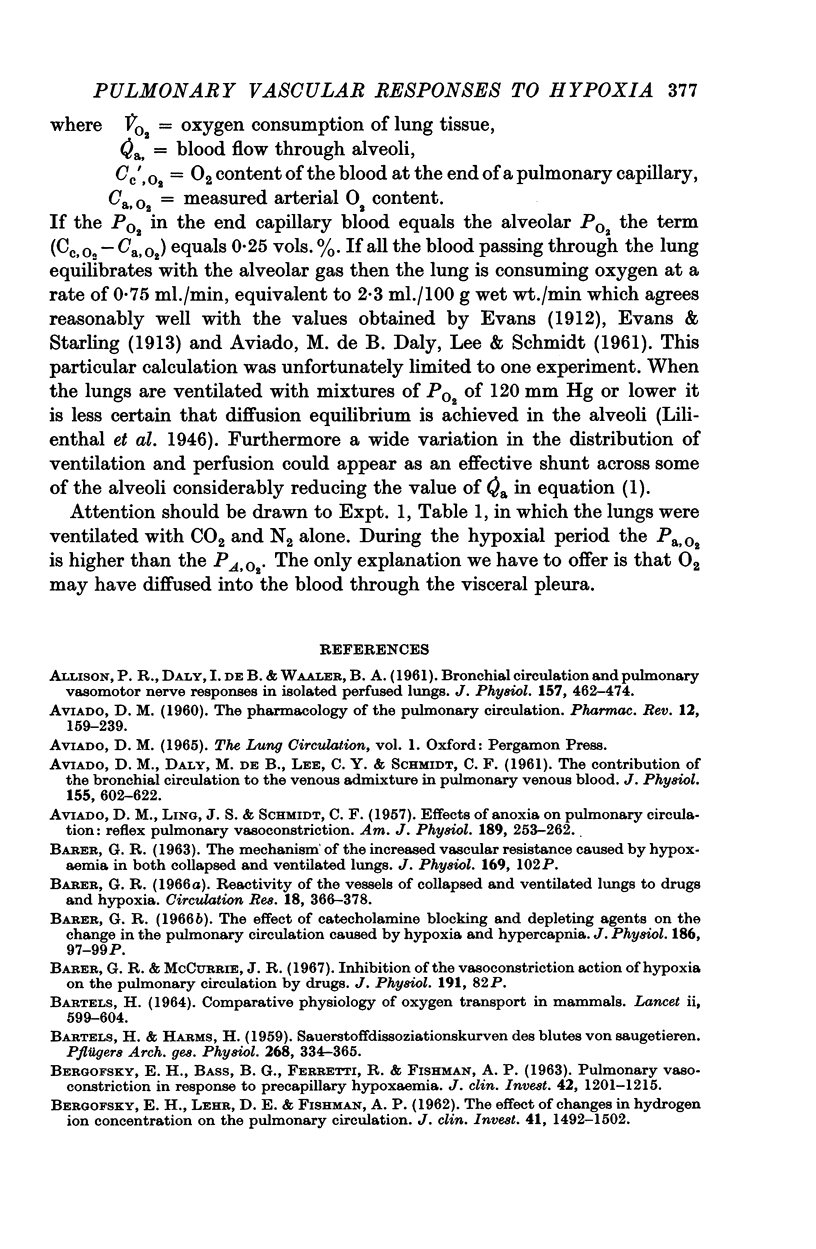
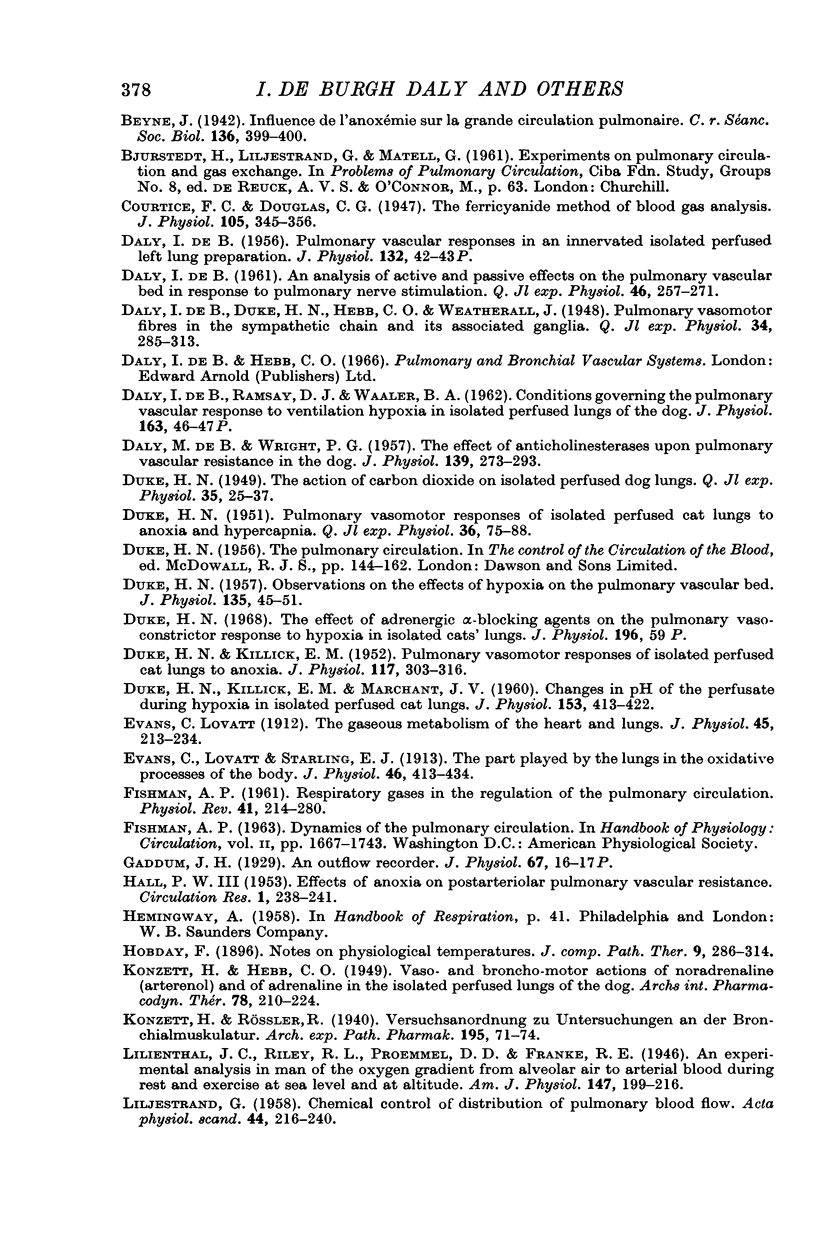
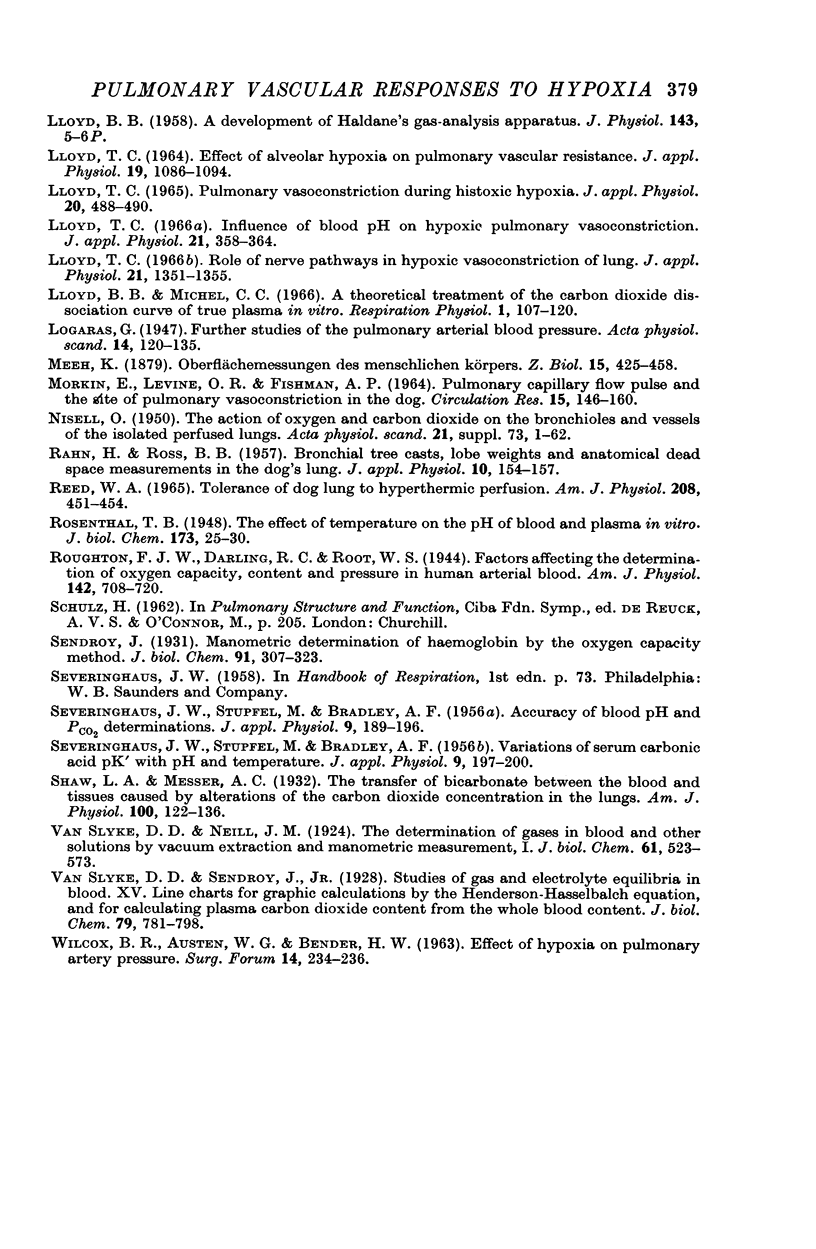
Selected References
These references are in PubMed. This may not be the complete list of references from this article.
- ALLISON P. R., DE BURGH DALY I., WAALER B. A. Bronchial circulation and pulmonary vasomotor nerve responses in isolated perfused lungs. J Physiol. 1961 Aug;157:462–474. doi: 10.1113/jphysiol.1961.sp006736. [DOI] [PMC free article] [PubMed] [Google Scholar]
- AVIADO D. M., DALY M. D., LEE C. Y., SCHMIDT C. F. The contribution of the bronchial circulation to the venous admixture in pulmonary venous blood. J Physiol. 1961 Mar;155:602–622. doi: 10.1113/jphysiol.1961.sp006650. [DOI] [PMC free article] [PubMed] [Google Scholar]
- AVIADO D. M., Jr, LING J. S., SCHMIDT C. F. Effects of anoxia on pulmonary circulation: reflex pulmonary vasoconstriction. Am J Physiol. 1957 May;189(2):253–262. doi: 10.1152/ajplegacy.1957.189.2.253. [DOI] [PubMed] [Google Scholar]
- AVIADO D. M. The pharmacology of the pulmonary circulation. Pharmacol Rev. 1960 Jun;12:159–239. [PubMed] [Google Scholar]
- BARTELS H. COMPARATIVE PHYSIOLOGY OF OXYGEN TRANSPORT IN MAMMALS. Lancet. 1964 Sep 19;2(7360):601–604. [PubMed] [Google Scholar]
- BARTELS H., HARMS H. Sauerstoffdissoziationskurven des Blutes von Säugetieren (Mensch, Kaninchen, Meerschweinchen, Hund, Katze, Schwein, Rind und Schaf. Pflugers Arch. 1959;268(4):334–365. doi: 10.1007/BF00380734. [DOI] [PubMed] [Google Scholar]
- BERGOFSKY E. H., BASS B. G., FERRETTI R., FISHMAN A. P. PULMONARY VASOCONSTRICTION IN RESPONSE TO PRECAPILLARY HYPOXEMIA. J Clin Invest. 1963 Aug;42:1201–1215. doi: 10.1172/JCI104806. [DOI] [PMC free article] [PubMed] [Google Scholar]
- BERGOFSKY E. H., LEHR D. E., FISHMAN A. P. The effect of changes in hydrogen ion concentration on the pulmonary circulation. J Clin Invest. 1962 Jul;41:1492–1502. doi: 10.1172/JCI104604. [DOI] [PMC free article] [PubMed] [Google Scholar]
- BRADLEY A. F., SEVERINGHAUS J. W., STUPFEL M. Accuracy of blood pH and PCO2 determinations. J Appl Physiol. 1956 Sep;9(2):189–196. doi: 10.1152/jappl.1956.9.2.189. [DOI] [PubMed] [Google Scholar]
- BRADLEY A. F., SEVERINGHAUS J. W., STUPFEL M. Variations of serum carbonic acid pK with pH and temperature. J Appl Physiol. 1956 Sep;9(2):197–200. doi: 10.1152/jappl.1956.9.2.197. [DOI] [PubMed] [Google Scholar]
- Barer G. R., McCurrie J. R. Inhibition of the vasoconstrictor action of hypoxia on the pulmonary circulation by drugs. J Physiol. 1967 Jul;191(2):82P–83P. [PubMed] [Google Scholar]
- Barer G. R. Reactivity of the vessels of collapsed and ventilated lungs to drugs and hypoxia. Circ Res. 1966 Apr;18(4):366–378. doi: 10.1161/01.res.18.4.366. [DOI] [PubMed] [Google Scholar]
- Barer G. R. The effect of catecholamine blocking and depleting agents on the changes in the pulmonary circulation caused by hypoxia and hypercapnia. J Physiol. 1966 Oct;186(2):97P–99P. [PubMed] [Google Scholar]
- Courtice F. C., Douglas C. G. The ferricyanide method of blood-gas analysis. J Physiol. 1947 Jan 15;105(4):345–356. [PMC free article] [PubMed] [Google Scholar]
- DALY I. D. An analysis of active and passive effects on the pulmonary vascular bed in response to pulmonary nerve stimulation. Q J Exp Physiol Cogn Med Sci. 1961 Jul;46:257–271. doi: 10.1113/expphysiol.1961.sp001542. [DOI] [PubMed] [Google Scholar]
- DE DALY I. B. Pulmonary vascular responses in an innervated isolated perfused left lung preparation. J Physiol. 1956 May 28;132(2):42–3P. [PubMed] [Google Scholar]
- DE DALY M. B., WRIGHT P. G. The effects of anticholinesterases upon pulmonary vascular resistance in the dog. J Physiol. 1957 Dec 3;139(2):273–293. doi: 10.1113/jphysiol.1957.sp005890. [DOI] [PMC free article] [PubMed] [Google Scholar]
- DUKE H. N., KILLICK E. M., MARCHANT J. V. Changes in pH of the perfusate during hypoxia in isolated perfused cat lungs. J Physiol. 1960 Oct;153:413–422. doi: 10.1113/jphysiol.1960.sp006543. [DOI] [PMC free article] [PubMed] [Google Scholar]
- DUKE H. N., KILLICK E. M. Pulmonary vasomotor responses of isolated perfused cat lungs to anoxia. J Physiol. 1952 Jul;117(3):303–316. doi: 10.1113/jphysiol.1952.sp004750. [DOI] [PMC free article] [PubMed] [Google Scholar]
- DUKE H. N. Observations on the effects of hypoxia on the pulmonary vascular bed. J Physiol. 1957 Jan 23;135(1):45–51. doi: 10.1113/jphysiol.1957.sp005692. [DOI] [PMC free article] [PubMed] [Google Scholar]
- Evans C. L., Starling E. H. The part played by the lungs in the oxidative processes of the body. J Physiol. 1913 Aug 18;46(6):413–434. doi: 10.1113/jphysiol.1913.sp001599. [DOI] [PMC free article] [PubMed] [Google Scholar]
- Evans C. L. The gaseous metabolism of the heart and lungs. J Physiol. 1912 Oct 22;45(4):213–234. doi: 10.1113/jphysiol.1912.sp001548. [DOI] [PMC free article] [PubMed] [Google Scholar]
- FISHMAN A. P. Respiratory gases in the regulation of the pulmonary circulation. Physiol Rev. 1961 Jan;41:214–280. doi: 10.1152/physrev.1961.41.1.214. [DOI] [PubMed] [Google Scholar]
- HALL P. W., Jr, HALL P. W., 3rd Effects of anoxia on postarteriolar pulmonary vascular resistance. Circ Res. 1953 May;1(3):238–241. doi: 10.1161/01.res.1.3.238. [DOI] [PubMed] [Google Scholar]
- LILJESTRAND G. Chemical control of the distribution of the pulmonary blood flow. Acta Physiol Scand. 1958 Dec 15;44(3-4):216–240. doi: 10.1111/j.1748-1716.1958.tb01623.x. [DOI] [PubMed] [Google Scholar]
- LLOYD T. C., Jr EFFECT OF ALVEOLAR HYPOXIA ON PULMONARY VASCULAR RESISTANCE. J Appl Physiol. 1964 Nov;19:1086–1094. doi: 10.1152/jappl.1964.19.6.1086. [DOI] [PubMed] [Google Scholar]
- Lloyd B. B., Michel C. C. A theoretical treatment of the carbon dioxide dissociation curve of true plasma in vitro. Respir Physiol. 1966;1(2):107–120. doi: 10.1016/0034-5687(66)90010-7. [DOI] [PubMed] [Google Scholar]
- Lloyd T. C., Jr Influence of blood pH on hypoxic pulmonary vasoconstriction. J Appl Physiol. 1966 Mar;21(2):358–364. doi: 10.1152/jappl.1966.21.2.358. [DOI] [PubMed] [Google Scholar]
- Lloyd T. C., Jr Pulmonary vasoconstriction during histotoxic hypoxia. J Appl Physiol. 1965 May;20(3):488–490. doi: 10.1152/jappl.1965.20.3.488. [DOI] [PubMed] [Google Scholar]
- Lloyd T. C., Jr Role of nerve pathways in the hypoxic vasoconstriction of lung. J Appl Physiol. 1966 Jul;21(4):1351–1355. doi: 10.1152/jappl.1966.21.4.1351. [DOI] [PubMed] [Google Scholar]
- MORKIN E., LEVINE O. R., FISHMAN A. P. PULMONARY CAPILLARY FLOW PULSE AND THE SITE OF PULMONARY VASOCONSTRICITON IN THE DOG. Circ Res. 1964 Aug;15:146–160. doi: 10.1161/01.res.15.2.146. [DOI] [PubMed] [Google Scholar]
- McIntyre A. K. Cortical projection of impulses in the interosseous nerve of the cat's hind limb. J Physiol. 1962 Aug;163(1):46–60. doi: 10.1113/jphysiol.1962.sp006958. [DOI] [PMC free article] [PubMed] [Google Scholar]
- RAHN H., ROSS B. B. Bronchial tree casts, lobe weights and anatomical dead space measurements in the dog's lung. J Appl Physiol. 1957 Jan;10(1):154–157. doi: 10.1152/jappl.1957.10.1.154. [DOI] [PubMed] [Google Scholar]
- REED W. A. TOLERANCE OF DOG LUNG TO HYPERTHERMIC PERFUSION. Am J Physiol. 1965 Mar;208:451–454. doi: 10.1152/ajplegacy.1965.208.3.451. [DOI] [PubMed] [Google Scholar]
- WILCOX B. R., AUSTEN W. G., BENDER H. W. EFFECT OF HYPOXIA ON PULMONARY ARTERY PRESSURE. Surg Forum. 1963;14:234–236. [PubMed] [Google Scholar]


